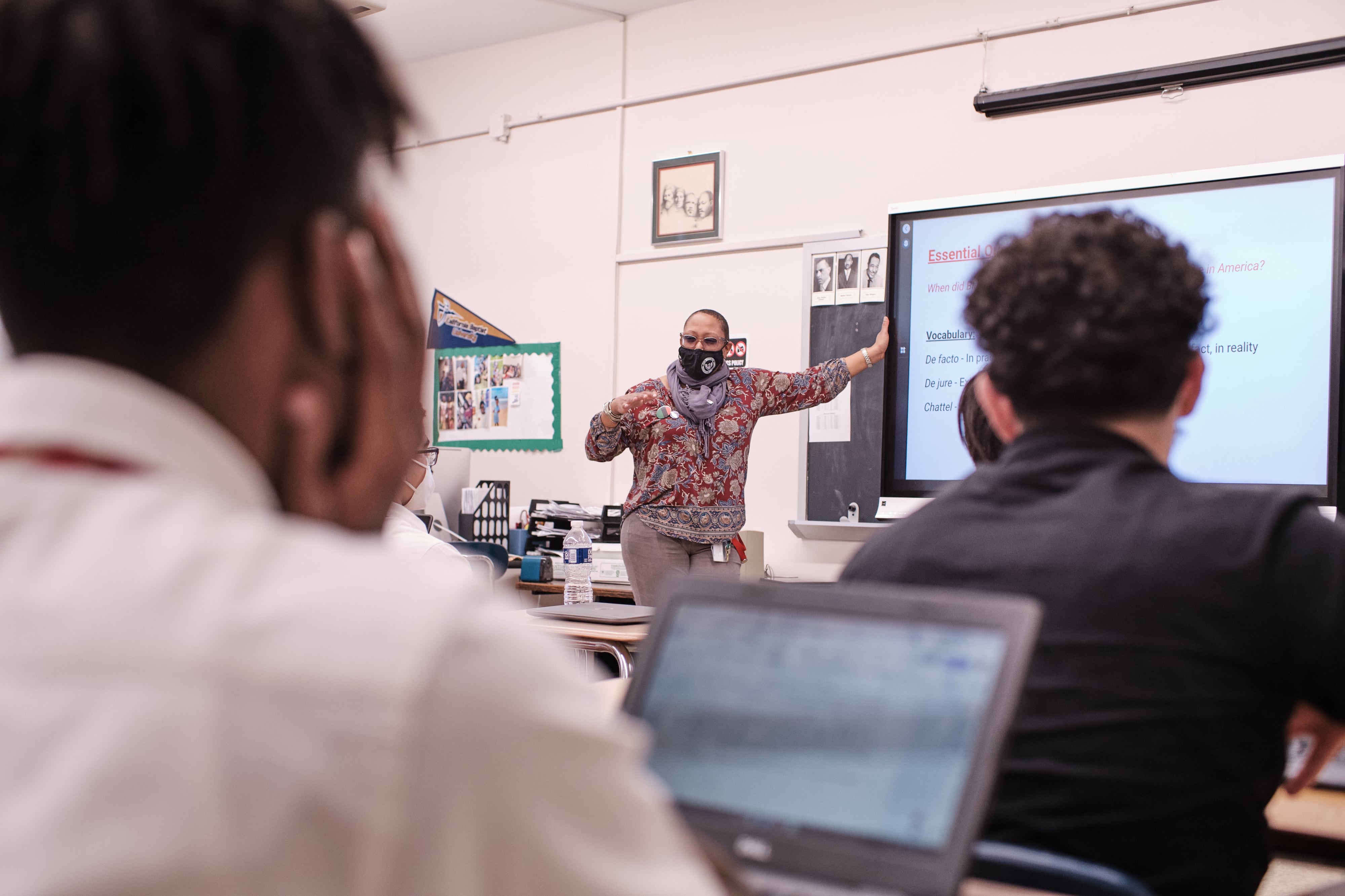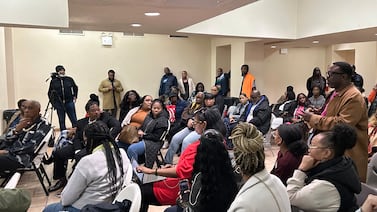Soon after a wave of states moved to restrict lessons on topics like racism and sexism, reports of stifled classroom discussions began to surface.
But it was unclear just how common that experience was until now. In a new nationally representative survey, 1 in 4 teachers said they were told by school or district leaders to limit their classroom conversations about political and social issues.
A higher share of teachers, nearly 1 in 3, said they’d gotten those orders while working in a state with an official restriction on teaching about racism, sexism, or other contentious topics. But teachers in states without official policies also felt that pressure: Just over 1 in 5 said they’d been told to limit their classroom discussions, too.
The survey, released on Wednesday by the RAND Corporation, represents one of the best summations to date of how early efforts to restrict teaching about racism and sexism have affected schools and reshaped classroom conversations.
The survey is based on responses from nearly 2,400 K-12 teachers earlier this year, when 14 states had laws or official policies limiting how schools can teach about race, racism, or other forms of bias. Since then, three more states have added similar restrictions, according to a tracker maintained by Education Week, and others are still considering them.
This school year, as new laws or policies take effect, more teachers will be figuring out how to navigate these restrictions for the first time.
In Kentucky, for example, a law passed in April prohibits schools from teaching that an individual bears responsibility for actions committed by other members of their race or sex — a provision that’s limited conversations elsewhere about white and male privilege. The law also says it’s “destructive to the unification of our nation” to teach that racial disparities are based “solely” in the legacy of slavery and Jim Crow laws, a provision some worry will make it harder for teachers to draw connections between past and present forms of discrimination.
Sara Green, who teaches eighth grade social studies in Kentucky’s Fayette County schools and sits on the state’s teachers advisory council, says she and other social studies teachers are worried they’ll be more scrutinized this year after seeing what happened in other states that passed similar laws.
Her class spans the colonization of North America to Reconstruction — subjects that hit on lots of “racism, sexism and other ‘isms,’” Green said. Her students often have many questions and debates about whether Reconstruction was a success or a failure, and why Abraham Lincoln advocated for the end of slavery, but didn’t believe in racial equality.
“We are worried about being able to present the information that we have been trained to present,” she said, “and then possibly facing backlash from the public or from parents. That definitely is a concern.”
While plenty of teachers across the country say they haven’t changed their lessons, these restrictions have had a chilling effect.
Last school year, teachers reported cutting short conversations with students about slavery and the genocide of Native Americans because of new state restrictions. Some educators avoided using phrases like “systemic racism,” or skipped over PowerPoint slides about the fight for gay rights. As legislation worked its way through the Iowa statehouse, education officials there scrapped an equity conference designed to help teachers better support students of color.
RAND researchers heard echoes of that in their interviews with teachers. Some said they weren’t allowed to add more voices of color to their lessons, while others said they had to check their lessons against district policies or state laws for compliance. Sometimes parents put pressure on school leaders that filtered down to classrooms.
“I have had parents come in and say, ‘If this is what you’re going to teach, my student doesn’t need to know about this,’” one teacher told the RAND researchers. The teacher recalled their principal’s response was: “I don’t really think this is a good topic.”
That pressure isn’t being applied everywhere. The survey found that teachers of color who worked mostly with other teachers of color or with students of color were less likely to say they’d been told to limit their classroom conversations, suggesting their schools and the families they serve are more supportive of classroom conversations about race, racism, and bias, the researchers wrote.
When teachers are told to limit their classroom discussions about certain politicized topics, it seems to make those tricky conversations even harder to have.
The survey found that 38% of teachers who had no official limitations on what they could talk about in class felt like they hadn’t gotten enough guidance on how to have conversations about hot-button political and social issues. But a higher share of the teachers who did have to navigate restrictions — 56% — felt like they’d gotten insufficient guidance to have those conversations with their students.
“This finding suggests that teachers may not clearly understand what is or is not allowed or how to carry out instruction within the confines of these directives,” the RAND researchers wrote.
Social studies and English teachers, who are most likely to touch on these issues in class, are especially in need of better guidance about how to follow new policies or laws, the researchers said.
In several cases, when states have passed laws restricting lessons on racism, sexism, or other forms of bias, teachers have gotten little guidance on how to follow those rules. That trend has only continued.
Mississippi lawmakers, for example, passed a law in March that says schools can’t teach that any sex, race, or nationality is “inherently superior or inferior” — again a provision that can limit conversations about white privilege. Schools also can’t “make a distinction or classification” of students based on race.
Teachers and civil rights groups wanted to know how the law would be enforced, since schools that violate the provisions risk losing state funding. “The biggest fear we have is that it’s going to impact how teachers teach and how school districts embrace diversity and issues dealing with civil rights or Black history in Mississippi,” Jarvis Dortch, the head of Mississippi’s chapter of the ACLU, told Mississippi Today earlier this year.
But state education officials haven’t put out any guidance about how to follow the law, and they don’t plan to. That’s because they believe the requirements “are compatible with existing academic standards and expectations for Mississippi public schools,” Jean Gordon Cook, a spokesperson for the Mississippi education department, wrote in an email.
Kentucky issued some guidance about its new law, but it includes almost nothing about how to put the law into practice in the classroom.
Teachers from across Kentucky have been working over the last few months to adjust the state’s social studies standards to comply with another part of the new law that requires schools to incorporate 24 documents and speeches into their middle and high school lessons by July 2023.
Green and other Kentucky teachers already taught many of those documents, such as the Mayflower Compact, the Declaration of Independence, and the U.S. Constitution, but other selections, like a speech by Ronald Reagan, raised questions. Green and others wondered why it constituted a “fundamental” American document, noting that the list doesn’t have any texts by Black women or Latino authors.
As those 24 documents get woven into the state standards, Green says she’d like more guidance on when and how the texts should be taught, and how deeply students should dive into them at various grade levels.
But the law also is presenting Green with a new teachable moment: When she covers required texts in her lessons, she can talk with her students about how they became part of the law and why.
“We oftentimes look at laws that differ from state to state,” she said. “The kids are interested in things like that. I don’t think there is anything wrong with letting them know: This is how this came about. What do you think about it?”
Having trouble viewing this survey? Go here.
Kalyn Belsha is a national education reporter based in Chicago. Contact her at kbelsha@chalkbeat.org.






